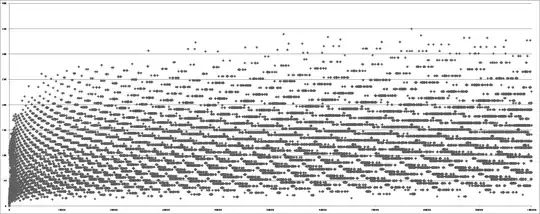I've been messing around with the Collatz sequences a bit, and have come across a few patterns - I was wondering if there are any known explanations for these patterns.
The first is the plot of stopping times (sequence lengths) for all Collatz sequences beginning with the first $100,000$ integers. As confirmed by both the wikipedia page and by this quick Python script/Excel plot, this strange line-pattern exists in the stopping times:

Another pattern was in the number of "hits" for each number. By that, I mean the number of unique sequences a specific number exists in. Generated by this similar Python script, its showing very strange patterns (if anyone wants the excel file generated, its here- just make sure you don't select the ads that look like download buttons). Specifically, one of the patterns I immediately noticed was this counting patterns - every third integer has a countdown number of hits. For example, here are the first 20 integers:
$$ \begin{array}{c|c} 1 &0 \\ 2 &99998 \\ 3 &16 \\ 4 &99997 \\ 5 &93742 \\ 6 &15 \\ 7 &19146 \\ 8 &99996 \\ 9 &14 \\ 10 &93741 \\ 11 &44375 \\ 12 &14 \\ 13 &47646 \\ 14 &19145 \\ 15 &13 \\ 16 &99995 \\ 17 &46031 \\ 18 &13 \\ 19 &17685 \\ 20 &93724 \\ \end{array} $$
Notice how everything else looks random, but every third integer counts down. This pattern remains throughout the whole of the $100,000$ integers (though the spaces between each different number in the countdown increase dramatically).
If anyone knows an explanation for these patterns, or can direct me towards further reading about these patterns, it'd be grealy appreciated.